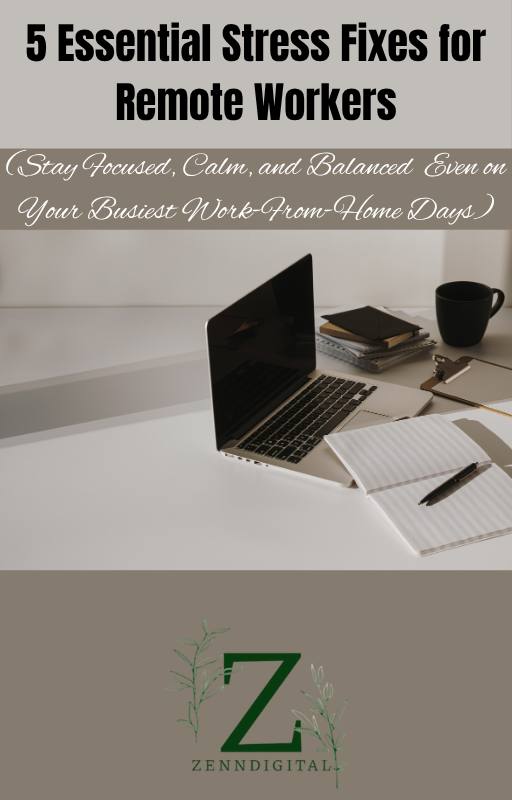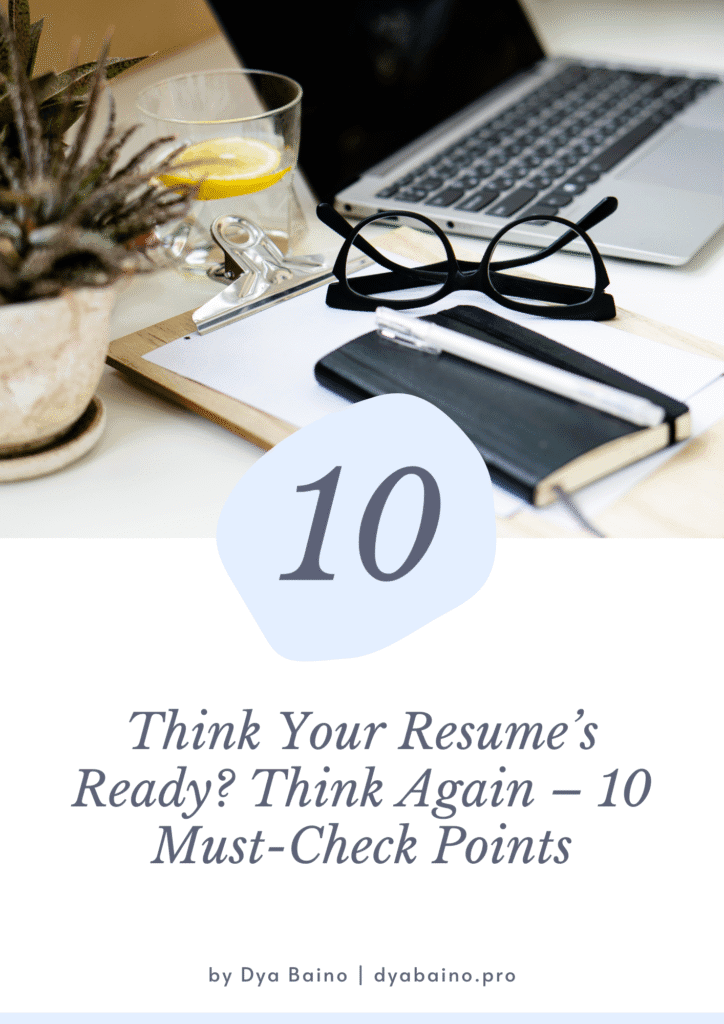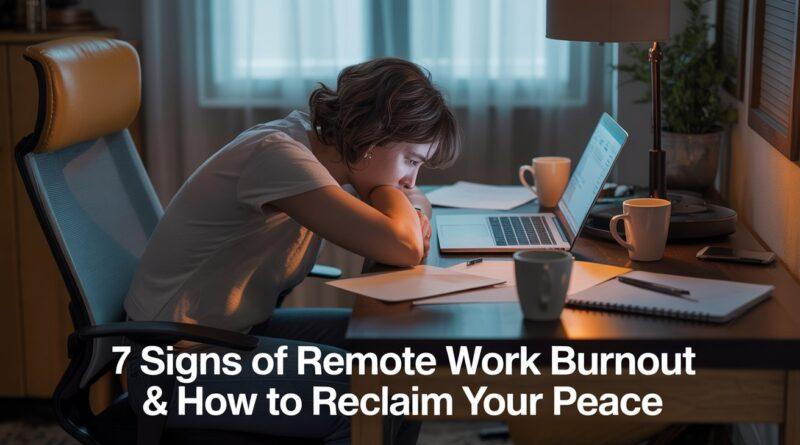7 Signs of Remote Work Burnout & How to Reclaim Your Peace
Prefer to listen to this article? Press play below: ps
The line between the living room couch and the corporate office has never been blurrier. Your « commute » is a ten-step shuffle from the coffee machine to your laptop. You have more flexibility, more autonomy, and no one stealing your favorite mug from the office kitchen. On paper, it’s the dream.
So why do you feel so exhausted?
Why do the days feel simultaneously endless and unproductive? Why does the glow of your laptop screen feel more draining than a boardroom full of people?
If this sounds familiar, you’re not just « tired of working from home. » You are likely standing on the edge of a cliff called remote work burnout. It’s a silent, creeping exhaustion that a weekend of Netflix binging can’t fix. It’s a unique 21st-century ailment born from the fusion of our homes and our workplaces.
But here’s the crucial truth: Remote Work Burnout is not a personal failing. It is a workplace problem, and more importantly, it is a solvable one.
This is not another article telling you to « just practice self-care. » This is a deep dive: a comprehensive guide to understanding the unique anatomy of remote work burnout, diagnosing its symptoms in your own life, and implementing powerful, practical strategies to not only recover but to build a sustainable, fulfilling, and balanced remote career.
We will explore the foundational pillars of a healthy work-from-home life. And for those whose burnout signals a deeper need for change, we’ll even touch on how to prepare for your next career move. You have the power to fix this. Let’s get started.
Part 1: The Anatomy of Remote Work Burnout
To defeat an enemy, you must first understand it. Remote work burnout isn’t just stress. Stress is characterized by over-engagement, a sense of urgency, and hyperactivity. Burnout is the opposite: it’s disengagement, helplessness, and emotional exhaustion. The World Health Organization (WHO) officially recognizes burnout as an « occupational phenomenon » resulting from chronic workplace stress that has not been successfully managed.
When your office is your home, the factors that lead to this chronic stress multiply and become harder to escape.
The 7 Silent Symptoms of Remote Work Burnout
Remote Work Burnout rarely announces itself. It arrives in subtle whispers. See how many of these resonate with you:
- Chronic Emotional and Physical Exhaustion: This is the hallmark symptom. It’s a bone-deep weariness that sleep doesn’t seem to touch. You wake up feeling just as tired as when you went to bed. The thought of opening your email feels like a monumental task.
- Increased Cynicism and Detachment (The « Quiet Quitting » Phenomenon): You start feeling disconnected from your work, your colleagues, and your company’s mission. You might find yourself becoming cynical or irritable in meetings. The work that once felt meaningful now feels like a series of pointless tasks. This is the very heart of « quiet quitting, » where you’re still logged on but have mentally checked out.
- A Gnawing Sense of Ineffectiveness: Despite working longer hours, you feel like you’re achieving less. Your productivity plummets, and a fog of « brain fog » makes it hard to concentrate or be creative. This leads to a vicious cycle: you work more to compensate for low productivity, which only leads to more exhaustion.
- Digital Hyper-Connectivity and Anxiety: You feel a constant, low-grade anxiety about being available. You check Slack or emails at dinner, right before bed, and the moment you wake up. The green « active » dot on your status becomes a source of pressure, a modern-day digital leash.
- Loss of Professional Identity: Without the physical office, chance encounters, and casual feedback, your sense of professional self can start to erode. You’re no longer « the go-to person for X » in the office; you’re just an icon on a screen, making it harder to feel valued and recognized.
- Social Isolation and Loneliness: While you may be surrounded by family or roommates, you miss the unique social fabric of a workplace. The casual chats, the inside jokes, the shared frustrations—these small interactions are surprisingly critical for mental well-being and are difficult to replicate over scheduled Zoom calls.
- Blurred Work-Life Boundaries: Your laptop is on the kitchen table. Your phone buzzes with work notifications while you’re trying to watch a movie. Your home, once a sanctuary, is now filled with the mental clutter of your job. There is no « off » switch.
If you nodded along to three or more of these symptoms, it’s a clear sign that you’re experiencing remote work burnout. The causes are not your fault; they are baked into the very structure of unstructured remote work.
Part 2: The Pillars of Balance: Foundational Strategies to Rebuild Your Fortress
Recovering from Remote Work Burnout isn’t about a single grand gesture; it’s about rebuilding your daily life around a set of foundational pillars. These pillars create the structure needed to protect your time, energy, and mental health. We will cover the core concepts here.
Pillar 1: Reclaim Your Physical Space
When your home is your office, your brain loses the environmental cues that tell it when to be in « work mode » and when to be in « rest mode. » You must recreate them intentionally.
- Create a Dedicated Workspace: Even if it’s just a small corner of a room, have a designated spot that is for work and work only. When you are there, you are working. When you leave, you are not. Avoid working from your bed or couch at all costs, as these places must remain sacred spaces for relaxation.
- The « End of Day » Pack-Up: At the end of your workday, physically put your work away. Close the laptop and put it in a drawer. Put your notepad and pens away. Tidy the space. This small ritual signals to your brain that the workday is officially over.
- Invent a « Fake Commute »: The commute used to serve as a mental buffer between work and home. Recreate it. Before you start work, go for a 15-minute walk around the block. Listen to a podcast. Do the same thing when your workday ends. This creates a clear, psychological separation between your professional and personal life.
Pillar 2: Master Your Time and Attention
In an office, your time is naturally structured by meetings, lunch breaks, and colleagues stopping by. At home, time can feel like an amorphous blob. You must be the architect of your own schedule to manage your Remote Work Burnout
- Time-Blocking is Your Best Friend: Instead of a simple to-do list, block out specific times on your calendar for specific tasks. For example, 9-10 AM: Answer emails. 10-12 PM: Deep work on Project X. 12-1 PM: Lunch (non-negotiable). This prevents multitasking and helps you focus.
- Implement a « Shutdown Ritual »: This is the most powerful habit for preventing remote work burnout. At a set time each day (e.g., 5:30 PM), perform a series of actions that finalize your work. This could include:
- Reviewing your to-do list for tomorrow.
- Sending a final « end of day » update on Slack.
- Closing all work-related tabs and applications.
- Saying a phrase out loud, like « Shutdown complete. » This ritual tells your brain that it is safe to disengage completely.
- Embrace Asynchronous Communication: The pressure to respond instantly is a major driver of burnout. Champion « async-first » communication with your team. Make it clear that it’s okay not to respond to a non-urgent email or message immediately. This breaks the cycle of constant reactivity.
Pillar 3: Protect Your Mind and Energy
Your mental energy is your most valuable asset. The digital world is designed to steal it. You must actively defend it.
- Curate Your Digital Environment: Turn off all non-essential notifications on your phone and computer. You don’t need a banner to pop up every time you get an email. Schedule specific times to check email and messages, rather than letting them interrupt you all day.
- Schedule « Unavailability »: Just as you schedule meetings, schedule breaks. Put them in your calendar so they feel official. A 10-minute break to stretch, a 30-minute lunch away from your desk, or a 15-minute « thinking time » walk are not luxuries; they are necessities for maintaining cognitive performance.
- Set Clear Boundaries with Colleagues and Superiors: This can be the hardest part, but it’s crucial. Communicate your working hours clearly. If you don’t work after 6 PM, don’t answer messages after 6 PM. Initially, it might feel uncomfortable, but people learn to respect the boundaries you set and enforce.
These pillars are the framework for a healthier remote work life. But to truly make a change, you need actionable, easy-to-implement steps that you can start using from day one. That’s why I’ve distilled the most effective techniques (the quick wins that make the biggest impact) into a simple, free guide.
Download your free copy of « 5 Essential Stress Fixes for Remote Workers » and start making a tangible difference today. It’s designed to give you immediate relief and put you back in control of your workday.

Part 3: The Narrative Bridge: Is It Just Burnout, or Is It Time for a Change?
You can implement every strategy in the book, build the most perfect remote work routine, and yet… still feel that deep, gnawing sense of exhaustion and disengagement.
If that’s the case, it’s time to ask a tougher question.
What if the burnout isn’t just a reaction to how you’re working, but a symptom of a fundamental mismatch with what you are doing, or where you are doing it?
Chronic burnout is often your psyche’s final, desperate alarm bell, signaling that you are deeply misaligned with your current role, company culture, or career path. It’s the friction of your true self grinding against a job that no longer fits.
Think about it:
- Does the work itself genuinely interest you anymore?
- Do you feel respected and valued by your team and manager?
- Does the company’s mission and culture energize you or drain you?
- When you think about your career path at this company, do you feel excitement or dread?
If your answers to these questions are overwhelmingly negative, then all the productivity hacks in the world will just be temporary fixes. They are treating the symptoms, not the underlying disease. The Remote Work Burnout will always return because the core problem (the misalignment) hasn’t been addressed.
This realization can be terrifying, but it’s also incredibly liberating. It means you are not broken; you are simply in the wrong place. The burnout is not a sign of failure; it is a compass, pointing you toward a necessary change.
If this resonates with you, and you’re starting to feel that the problem isn’t just your routine, but your role itself, it might be time to start exploring new opportunities.
Taking that first step can be daunting, but it begins with being prepared. You need to be ready when the right opportunity appears. And in the modern job market, readiness starts with a world-class resume that can get past the automated systems (ATS) and into the hands of a human.
To ensure you’re prepared for your next career move, I’m also offering my personal, proven checklist for crafting the perfect resume. It covers the key optimizations needed for 2025’s hiring landscape. Get your Free Resume Checklist here and take the first, empowering step toward a job that truly fits you.
Part 4: Advanced Strategies for a Sustainable Remote Career
Once you’ve addressed the immediate burnout and decided on your path (whether it’s improving your current job or seeking a new one), the final step is to build habits for long-term, sustainable success. This is about moving from recovery to thriving.
- Master the Art of Over-Communication: In an office, a lot is communicated non-verbally. Remotely, you must be more intentional. Proactively share what you’re working on, communicate your progress, and be explicit about your availability and any potential roadblocks. This reduces anxiety for both you and your manager, as it eliminates guesswork.
- Schedule « Connection Time »: Combat social isolation by scheduling non-work-related virtual events. A 15-minute « virtual coffee » with a colleague, a team-wide online game, or even a dedicated Slack channel for sharing hobbies can help rebuild the social fabric that’s lost when you’re not sharing a physical space.
- Conduct Regular « Work-Life Audits »: Once a month, take 30 minutes to review your work-life integration. Ask yourself:
- Have my work hours been creeping up?
- Am I feeling disconnected from my team?
- Am I taking enough real breaks?
- What is one small change I can make next month to improve my balance? This proactive self-assessment helps you catch the early signs of remote work burnout before it takes hold again.
- Invest in Your Ergonomics: Long-term physical discomfort is a major contributor to mental fatigue. If you’re going to be a remote worker for the long haul, invest in a good chair, a separate monitor at eye level, and an external keyboard and mouse. Your body will thank you, and your mind will have more energy to focus on what matters.
- Leverage Technology for Focus, Not Distraction: Use technology as a shield, not a sieve. Use apps that block distracting websites during your « deep work » blocks. Use project management tools to keep track of tasks so they don’t have to live in your head. Turn your tech stack from a source of stress into a suite of support.
Building a sustainable remote career is an ongoing practice, not a one-time fix. It requires intention, self-awareness, and the courage to constantly adjust your systems to protect your well-being.
Your Free Resources to Get Started:
- To fix your daily stress and Remote Work Burnout: Download the « 5 Essential Stress Fixes for Remote Workers » Guide
- To prepare for a new opportunity: Download the « Free Resume Checklist »
- to manage Remote Work Burnout and anxiety : read this



Frequently Asked Questions (FAQ)
1. How long does it take to recover from remote work burnout? There’s no single timeline for recovery; it’s a highly individual process. Recovery can take anywhere from a few months to over a year. The key factors are the severity of the remote work burnout, how quickly you implement changes, and the level of support you receive. The first step is acknowledging the issue and beginning to implement small, consistent changes. Be patient and compassionate with yourself.
2. Is changing jobs a guaranteed fix for burnout? Not necessarily. Changing jobs can be a powerful solution if the root cause of your remote work burnout is a toxic environment or a role that no longer fits. However, if the root cause is your own work habits or poor boundaries, you will likely carry those same patterns into a new job. It’s often a combination of both: you need to improve your personal work systems and be in a supportive environment.
3. What is the single most important habit to prevent remote work burnout? If you could only implement one habit, it should be the « Shutdown Ritual. » Creating a clear, deliberate end to your workday is the most effective way to combat the « always-on » culture that fuels remote work burnout. It builds a psychological boundary that allows your brain to truly disconnect and rest.
4. Should I talk to my manager about my remote work burnout? This is a delicate question. If you have a supportive manager, being open can be helpful. Frame the conversation around workload and finding sustainable ways of working, rather than just saying « I have remote work burnout. » If you fear reprisal, it may be wiser to focus on what you can control and seek support from HR or a mentor.
5. Are some people more prone to remote work burnout than others? Yes, certain personality traits can increase the risk of remote work burnout. High-achievers, perfectionists, and people who have difficulty setting boundaries are often more susceptible. Recognizing these tendencies is the first step toward consciously developing healthier work habits to counteract them.
Conclusion: You Are the Architect of Your Remote Work Life
Remote work burnout is real, it is debilitating, and it is on the rise. But it is not a life sentence. It is a signal, a call to action to re-evaluate, restructure, and reclaim your professional life from its grip.
We’ve seen that the causes are rooted in the unique challenges of our digital-first, work-from-anywhere world: the blurred boundaries, the digital presenteeism, the creeping isolation.
We’ve also seen that the solutions are within your grasp. By implementing the foundational pillars (reclaiming your space, mastering your time, and protecting your mind) you can treat the immediate symptoms and build a resilient framework for your daily work.
And perhaps most importantly, we’ve uncovered that sometimes, burnout is a compass. It can point you toward the courageous realization that you’re meant for something more, something different, something better aligned with who you are.
You now have a choice and a clear path forward, whatever you decide.
- If you’re ready to fix your current situation and bring immediate relief to your workdays, your first step is to dive into practical, actionable techniques.
- If you’ve realized a bigger change is needed, your first step is to prepare yourself for the opportunities that await.
You are the architect of your remote work life. You have the tools and the insight to design a career that is not only productive and successful but also healthy, balanced, and genuinely fulfilling. The work starts now.
Resources for Your Journey :
Your Personal Toolkit:
- To fix your daily stress: Download the « 5 Essential Stress Fixes for Remote Workers » Guide
- To prepare for a new opportunity: Download the « Free Resume Checklist »
Mental Health Organizations for Burnout Support:
- World Health Organization (WHO): Official guidance on occupational burnout and mental health in the workplace.
- National Alliance on Mental Illness (NAMI): Offers support groups and resources that can help if remote work burnout affects your mental health.
- Mental Health America (MHA): Provides screening tools to assess symptoms of stress and burnout.
Helpful Tools & Apps to Combat Remote Work Burnout:
- Meditation & Mindfulness: Apps like Headspace or Calm are excellent for managing the daily stress that leads to remote work burnout.
- Focus & Productivity: Tools like the Forest app help you build focus, a key skill to combat feelings of ineffectiveness from burnout.
- Time Management: Using a time-tracker like Toggl or Clockify can reveal work patterns that contribute to remote work burnout.
Recommended Reading on Burnout and Deep Work:
- « Deep Work » by Cal Newport: A book about developing the focus needed to thrive and avoid the shallow work that often causes Remote Work Burnout.
- « The 4-Hour Workweek » by Tim Ferriss: Offers radical ideas for creating a better work-life balance and escaping the « more is more » mindset of burnout.
- Harvard Business Review articles on « Burnout »: HBR offers many research-backed articles on identifying and preventing remote work burnout.


Super helpful and easy to follow!
This guide is packed with practical tips that actually make a difference when working remotely. The advice is clear, straightforward, and really easy to put into practice, even on the busiest days. I felt more focused and less stressed after just a few pages. Highly recommended for anyone working from home!
Hello ,
really enjoyed this article, super interesting and motivating!
Do you think the “Stress Less – A Beginner’s Guide + Daily Calm Planner” could actually help me get through my current situation a bit? Would you recommend buying it? I’m considering it but would love to have your opinion first. Thanks in advance! 😊
Yes, it’s a good planner! I found the tips easy to follow and the daily sections help me stay calm and organized. It’s definitely worth a try if you’re looking to manage stress better.